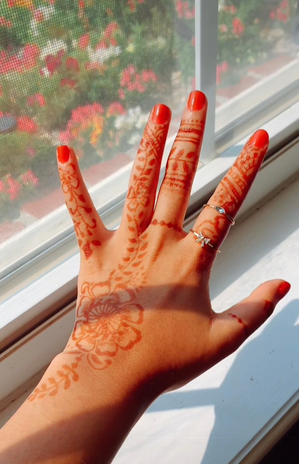Extravagant floral patterns climbing up the arms of a bride, delicate leafy vines encircling fingers of children, silky coarse hair tinted red– these are some of the many beautiful applications of Henna.
I have some precious memories attached to the art of Henna and Henna in general. I first got my Henna done when I was probably too young to remember– probably as a toddler for Eid, or some other celebratory day. Growing up, I remember always seeing my grandmother’s hair and my grandfather’s beard dyed red with Henna. When I would visit my family in Bangladesh, one of my older cousins would practice their Henna skills on my hands. During middle school and the early years of high school, my mom would try to apply Henna designs on me the night before our Eid celebrations. I have always associated Henna with my background, and as a second-generation immigrant born in the United States, I now see it as a way to connect back to my culture. My roots are in Bangladesh, and Henna are the leaves.
Henna, or “Mehendi” in some South Asian languages such as Bengali, Hindi, and Urdu, is a paste that is used as a temporary dye for skin, hair, nails, and fabric. For several millennia, the art of Henna has been practiced in African, Middle Eastern, and South Asian countries. It is a paste created from the leaves of the Lawsonia inermis plant, which is native to Africa, Asia, and Australia. It is commonly packaged in a tube to be used for Henna art– a temporary dye that sits on the skin’s surface. Once the brown paste hits the skin, it immediately starts staining, as an earthy aroma permeates the air. Experienced Henna artists find the perfect way to grip the tube and, while slowly adding pressure, gracefully glide across the skin as inspiration hits. When the dried paste is hardened and removed, it usually leaves behind a rich, reddish pigment.
The origins of Henna can be dated to 9,000 years ago, used by the Pharos in Egypt to adorn Queen Cleopatra’s body. Before it was popularized by many South Asian countries to be used for their weddings and traditional ceremonies, it was originally used for its natural cooling properties. For those living in hot desert climates, the leaf paste would be used to cover the palms of their hands and the soles of their feet.
It would also be used for medicinal purposes, used as a coagulant for open wounds, and used to relieve/ soothe burns and eczema. Fresh Henna leaves could be used as an antiseptic for fungal or bacterial skin infections as well. Additionally, while Henna can be used to dye hair, it can also improve hair health by softening hair and reducing its premature graying.
In South Asian cultures, Henna during wedding ceremonies is utilized to signify the bond between the bride and groom and the union of their families. Originally, Henna was only placed on the bride and women of the family, but eventually, men were added to this tradition as well. For women, “Mehendi Ceremonies” are commonly held the night before the wedding to wish luck to the bride, as well as to allow for the Henna to stain darker overnight. During Mehendi Ceremonies, the women of both sides of the family gather and also put Henna on themselves. A professional Henna artist is usually hired to create the designs on the bride, who tends to have the “most” designs– their arms are completely covered (whereas others may only have it on their hands up to their wrist). Floral designs are common and symbolize beauty and new beginnings.
Outside of weddings, Henna is applied during holidays, such as Eid and/or Holi; during national holidays, such as Independence Day of the respective countries; and during New Years, such as Pahela Baishakh (the first day of the Bengali calendar), as a way to celebrate. Additionally, the art of Henna and placing Henna on others is often seen as a type of bonding between those involved. In South Asian communities, there is often an “older sister” or “aunt” figure that people go to to get their Henna-art done.
Getting temporary Henna tattoos is now very common in all regions of the world– including the United States. It is intriguing how norms can change so quickly. I remember when I was a child, those who were not aware of Henna would point to the stains and ask if it was some sort of skin condition, but now, you can see people at zoos administering Henna onto customers (that’s how common it has become). It is important that all individuals who apply and receive Henna designs, no matter who you are or where you come from, understand the cultural significance behind the art and ancient practice. Respecting and crediting the cultures should always be a priority.


